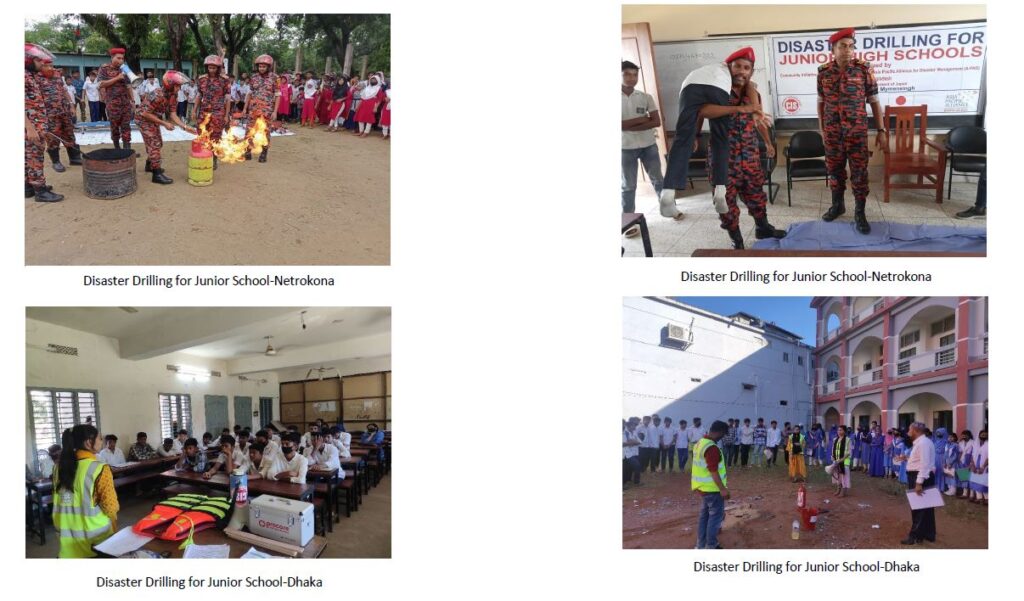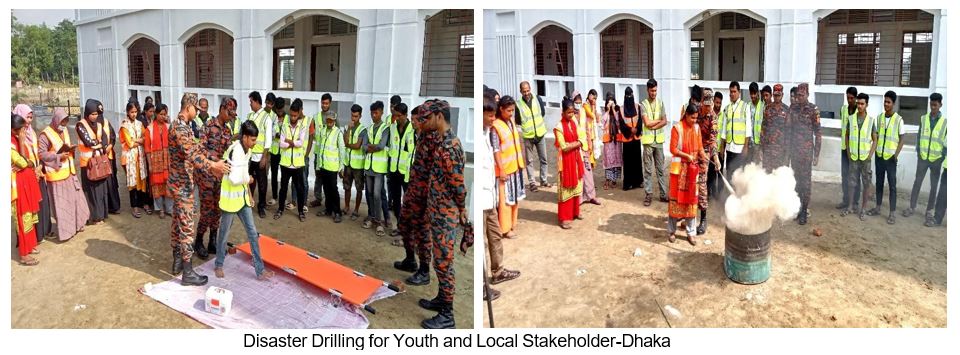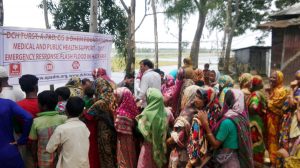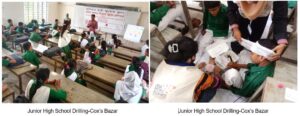Project Title: Strengthening Capacity for Sustainable Disaster Management Network by involving multi-sectoral platform Project Period: 17 January, 2023 – 16 January, 2024 (12 month)
- Project Activities and Accomplishments
Bangladesh is one of the most vulnerable countries to natural disasters and, due to climate change; we are facing natural disasters almost every year. Combined with the country’s geographical location, topography, and dense population, disaster events often result in high loss of life and economic loss, though Bangladesh has been successfully reducing the loss of human lives over the years. The frequency and intensity of natural disasters have increased in recent years due to climate change. The climatic events have serious consequences on broad agricultural sectors, food security, water, health, and sanitation and leave serious impacts on the life and livelihood of the communities. But so far we have limited disaster risk-related data to understand the depth of household and population characteristics and loss sustained by the community at the household levels.
A-PAD Bangladesh started the project in January 2023 and presently continues it on 17 January 2023 to build up capacity for disaster management. It communicates with the different sectors like the local community, community leaders, stakeholders, and GOVT. officials continuing training on disaster management. To hold a training program A-PAD Bangladesh staff organized small community meetings to share ideas on disasters and introduced them about A-PAD Bangladesh activity. A-PAD Bangladesh working 8 divisional areas.
There are 1 health workers in each divisions whose are doing home visit and aware the local community about basic disaster awareness. The health workers gave basic ideas about disaster management. A-PAD Bangladesh working at the rural areas. If there would be any directions or announcement from GOVT. or any disaster related news has been published the health workers delivered the message to the local community. Total 5,083 persons were benefited from A-PAD Bangladesh on December 2023.
A-PAD Bangladesh attended coordination meeting at the 8 divisions in Office of Deputy Commissioner. At that meeting different NGOs had joined and explained their activities. Besides this what will be the next activities of the GOVT. and NGOs were discussed at that meeting.
1. To manage the emergency disaster management coordination centers in disaster-prone areas (Outcome 1) The disaster management coordination center in disaster-vulnerable areas established in this project (3 year project) functions as a disaster response base in each region, and contributes for preventing the spread of health damage to local residents and community-led disaster risk reduction measures. | ||
Activities | Outcome Indicators to Measure Results: | Project Status: Achievements vs Outcome: If the activity is behind schedule, please write the reason. |
1-1 Operation of Emergency Disaster Management Coordination Centers Beneficiaries: 10 people x 25 days x 8 divisions x 12 months = 24,000 people 50 people x 8 campaign x 12 months = 4,800 people | 【Indicators of Outcome】 1-1: The disaster response management centers in 8 places (Dhaka, Chattagram, Rajshahi, Khulna, Barisal, Sylhet, Rangpur and Mymensingh division) will be utilized and the necessary equipment for emergency health care will be prepared. We will establish a new emergency disaster management coordination center in Mymensingh division. The center will function as a resource center for sharing information on disasters and will be used as a venue for strategic planning meetings, training and workshops. The staff members including doctors and nurses visit the villages and carry out awareness activities related to emergency health measures, public health and disaster prevention for local residents, and ensure that each local resident takes appropriate preventive measures. | Total of 4,241 people visited the Disaster Management Coordination Center to discuss disaster preparedness and health-related issues. Dhaka: 518 Persons Cox’s Bazar: 490 Persons Pabna: 530 Persons Bagerhat: 510 Persons Patuakhali: 525 Persons Habiganj: 650 Persons Rangpur: 520 Persons Netrokona: 498 Persons Total = 4,241 Persons |
1-2 Disaster Management Awareness program Beneficiaries:15 participants x 3 sessions x 8 divisions x 12 months = 4,320 people | A-PAD Bangladesh conducted Disaster Management Awareness programs at the 8 divisional areas where 382 persons participated. Total 3 times training was organized at each divisional area. Dhaka:15 Participants x 3 Sessions= 45+4=49 Participants Cox’s Bazar: 15 Participants x 3 Sessions=45+2=47 Participants | |
| (Indicator: number of visitors, record of services provided)
1-2: The PCR test lab installed in the previous project will continue to operate. In the first year of the project, testing will be conducted only for COVID-19. From the second year onwards, it will be expanded to other infectious diseases (tuberculosis, measles, hepatitis) according to the needs of local residents. (Indicator: number of tests, report of test results) | Pabna: 15 Participants x 3 Sessions= 45+1=46 Participants Bagerhat: 15 Participants x 3 Sessions= 45+5=50 Participants Patuakhali: 15 Participants x 3 Sessions= 45+2= 47Participants Habiganj: 15 Participants x 3 Sessions= 45+4= 49 Participants Rangpur: 15 Participants x 3 Sessions= 45+1=46 Participants Netrokona: 15 Participants x 3 Sessions= 45+3=48 Participants |
1-3 Operation of PCR lab Beneficiaries: 15 people x 25 days x 12 months = 4500 people(Monthly Goal: 15 persons x 25 days = 375 persons) |
A-PAD Bangladesh established PCR Lab for COVID-19 test. In Bangladesh, number of fever patients has average in number. In December 2023 total 320 COVID-19 test has been done | |
2 Strengthening the disaster response platform network (Outcome 2) A-PAD BGD, NPF for disaster reduction and disaster response through collaboration between multi-sectors, will be established and expanded, and the disaster prevention and disaster capacity of its member organizations will be strengthened. | ||
2-1 Network partner meeting Participants : 100 people x 5 villages x 8 divisions = 4000 people | 【Indicators of Outcome】 2-1 Strategies, mechanism and action plan meeting among networking partners and local communities will be held to support the building of disaster cooperation framework.
2-2 For the aim of awareness and increase the knowledge on disaster preparedness and management among the local community, we will organize different rally and meeting on the disaster preparedness and SDGs related |
|
2-2 Disaster Preparedness Campaigns Participants:100 people x 2 times x 8 divisions = 1,600 people |
| |
2.3 Network Partners Capacity Strengthening (DRR) Participants:30 people x 2 org x 8 divisions x 2 times =960 people | national/international days like 05 November World Tsunami Awareness Day, 13 October Disaster Risk Reduction Day, 22 April Earth Day and 16 December Victory Day (National).
2-3 For the aim of strengthening of partner organizations, disaster risk reduction (DRR) training will be held. The training contents includes community-based disaster risk management, planning DRR strategies, and risk analysis that effectively identifies hazards, capacities and vulnerabilities. (Indicator: Partner organizations)
2-4 In this seminar, participants from various fields will be invited to exchange opinions and discuss ways to discover innovations related to DRR proposed by community residents and local companies and realize ideas and inventions. (Indicator: To create innovative solutions, we aim to create a successful model for disaster response by combining technology and knowledge that transcends fields and innovating)
2-5 The international symposium will be held in Dhaka to widely share the cooperation between multi-actors |
|
2-4 Seminar for Developing New Disaster Prevention Solutions Participants:40persons x 8 divisions x 2times =640 participants |
| |
2-5 International Symposium on DRR
Participants:200 persons |
|
| at the central and regional levels in Bangladesh and the progress of the emergency health response system among participants who are involved in disaster response from inside and outside Bangladesh. International experts will be dispatched from A-PAD member countries to introduce advanced cases of NPF in each country. (Indicator: The international symposium will be held for a total of three days, one day for field trips (field visits), one day for pre-meetings, and one day for international symposiums.) |
|
3. Strengthening disaster resilience of local communities
(Outcome 3) 3-1 Disaster response capacity building of local community level in Health and hygiene field | ||
3-1 a) ) Workshop on Disaster Management and Emergency Health Response
Participants:40 persons x 8 divisions x 2 times = 640 persons | 【Indicator of Outcome】 3-1 a) Workshops will be held to understand emergency disaster preparedness, health response and hygiene needs in communities, schools and homes and to learn how to respond during emergencies. Networks of stakeholders will be built through the workshop. |
|
3-1 b) Training of Local Health Workers on Disaster Health Activities
Participants:25 pers/time x 8 divisions = 200 persons | (Indicator: Local citizens, Community leaders, Local NGO, Private sector workers)
b) Workshop for healthworkersfrom local organizationswillbeheld to understand emergency health and hygieneneeds and learn how to respond to emergencies. The healthworkerswhofinishedthis trainings are supposed to becomemember of disastervolunteerrescue team in the activity. |
|
3-2 Strengthening disaster response capacities of local communities through disaster drilling training | ||
3-2 a) Women Empowerment and Capacity Building Participants:20 persons X 8 Divisions X 2 Session = 320 participants | 3-2 a)Building women empower and capacity building through improving their knowledge and skills on disaster risk reduction, in order to involve them in disaster planning and policy making. A women’s group will be trained in the field of maternal and child health, hygiene and environment sanitation, nutrition. (Indicator: A women’s group will be trained in the field of maternal and child health, hygiene and environment sanitation, nutrition.)
b) Drilling training session will be conduct to the local stakeholders, youth group and homes and to learn how to respond the fire, flood, cyclone, landslide and |
|
3-2 b) Disaster Drilling for the Youth and Local Stakeholders Participants : 45 persons x 8 divisions x 2 times = 720 persons | A-PAD Bangladesh organized Disaster Drilling for the youth and local stakeholder in Dhaka. 09-10 December 2023, Dhaka, Total Participants 45+3
Involving youth in disaster planning and recovery can increase their awareness of hazardous situations that may occur in their neighborhood and teach them how to respond in various types | |
| earthquake disasters and rescue at the emergencies. To conduct this training session, we will prepare a training manual and a curriculum collaboration with the department of fire service and civil defense of GoB. (Indicator: After the practical training session two disaster volunteer rescue team will be established in each divisional area.)
c) Drilling training session for the public junior high school students and teachers will conduct at the school based focusing self-protection during and after disaster. Manual will be designed for the school children in cooperation with the department of fire service and civil defense of GoB (Indicator: Participated schools will be supported to develop their emergency management plans.)
In order to widely share and disseminate the activities of this project and the experiences and lessons learned through the activities, situation reports and activity reports in the event of a disaster will be published on the A-PAD BGD website. | of emergencies. When a disaster strikes not only adults will be affected but children as well. Special challenges may confront youth during an emergency. They may be separated from their parents, be too young to drive or lack access to a vehicle so that they can join their family, and need to be cared for by adults unknown to them until the disaster abates. Youth have incredible reserves of energy and may bring fresh new ideas to the table that adults have not considered. Pack Strap Carry Have the patient sit up if they’re able to. The patient should place their arms over your shoulders and hang on as you carefully stand up and carry them out. If the patient is unconscious, you can instead cross their arms, grab their wrists, and place their arms over your shoulders to drag the patient off the bed and carry them out.
Hip Carry First roll the patient onto their side and bend their legs at the knees. Take a seat on the edge of the bed next to the patient. Then, reach behind you to grab the patient from underneath the knees and underneath the far shoulder. Once you’re able to lift them, stand up, lean forward, and carry the patient on your hip.
Cradle Drop Lower the bed if possible and place a towel, sheet, or blanket on the floor beside the bed. Gently drag the patient off the bed, onto your knee, then onto the blanket. Then, fold the blanket at the corners near the patient’s head and drag the patient on the blanket. |
3-2 c) Disaster Drilling for Junior High Schools Participants : 45 persons x 8 divisions x 2 times = 720 persons |
| 02 days drilling programs for the Junior high school organized in Dhaka and Rangpur 04-05 December 2023, Netrokona, Total participants 45+2 17-18 December 2023, Dhaka, Total participants 45 Education is the birthright of every child. There are many reasons why education is vital for children. It develops wisdom and intelligence which help in being self-dependent in life. It plays a vital role in the development of personality. It develops confidence also and helps us to become a responsible citizen of the nation. CIS arranged a two days Disaster Drilling For Junior High School in Netrokona . This training was arranged in Atithpur Abbasis High School. The drilling program was held on 04,05 November and on the 1st day there was a brief discussion on theoretical knowledge on disaster and Hazard. Such as what is disaster and difference between disaster and hazard. Why disaster happen and how we can overcome this. There was also discussion on earthquake as what we need to do during a earthquake. On the 2nd day there was demonstration on specific fire incident as fire is one of the big issues in Bangladesh. Bangladesh Fire Service team was also present there and they gave a brief on fire incidents and shared some primary ideas for children on response how they can rescue there friend if there are any occurrence. How they can give primary medical support like how to do primary bandage. Fire service team also demonstrate cylinder fire related issues like how one can easily stop fire and what one should do during fire. The training program was arranged for children as the motto was to build a generation who have enough knowledge on disaster and disaster management. If we educate children they |
|
| will share their knowledge with their parents and siblings which will help to make a sustainable resilient community.
Schools are entrusted and share responsibility with the guardians to form future citizens. For youth and schools ‘authority, a safe and secure environment is a prerequisite for effective learning and teaching. To ensure the safety of young people, the basic knowledge in disaster and emergency management for teachers and staff together with active engagement of the high reliability organizations e.g. police, are necessary. However, a complete security and safety can only be achieved if the school and the youth can gain some expertise on the management of emergency situations. 1. Types of Disasters: · Identification and discussion of various types of disasters, including natural disasters such as earthquakes, floods, cyclones, and man-made disasters like fires and industrial accidents. · Understanding the specific vulnerabilities of Dhaka to different types of disasters. 2. Risk Assessment: · Conducting risk assessments to identify potential hazards in and around school premises and local communities. · Analyzing the likelihood and impact of different disasters to prioritize preparedness measures. · |
|
| 3. Emergency Evacuation Procedures: · Practical training on emergency evacuation procedures tailored to the school environment. · Guidance on safe evacuation routes, assembly points, and coordination during evacuation drills. 4. First Aid Training: · Basic first aid skills, including CPR, wound care, and addressing common injuries. · Understanding the importance of first responders and how timely intervention can mitigate the severity of injuries. 5. Emergency Communication Protocols: · Establishing effective communication channels during disasters. · Utilizing emergency contact information and communication devices for swift and coordinated responses. |
3-3 Update website contents as E-resources for Disaster Management | https://apad-bd.org/a-pad-bangladesh-activity-report-month- of-october-2023/ https://apad-bd.org/a-pad-bangladesh-activity-report-month- of-november-2023/ https://apad-bd.org/report-on-a-pad-bangladesh- international-symposium_07-november-2023/ https://apad-bd.org/our-national-platform-members/ https://apad-bd.org/wp-content/uploads/2023/12/3-1.jpg https://apad-bd.org/wp-content/uploads/2023/12/2-1.jpg |
- Challenges
Please write Challenges and its impact upon the project implementation. (Ex.lockdown, Political situation, Curfew)
- Practice in collaborationwithA-PAD Bangladesh Network Partners Please write good practice in collaboration with partner organizations
- Any contributionFunds Received and Grants Applied / Planned and Implemented Projects by CIS including Emergency Response Please write Projects name and its fund resources
- Relationship with Bangladesh Government and Japanese Embassy Please write about Meeting with Government officials






